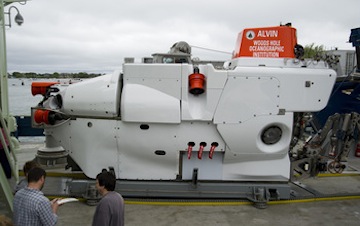350215-back in saddle.jpg

Starboard profile of Alvin on the fantail of its support vessel, the R/V Atlantis. Credit: WHOI (Woods Hole Oceanographic Institution)
More than a third of a century ago, scientists were cruising along the ocean floor off the Galapagos Islands when they saw something remarkable: a column of super-heated water bubbling up into the icy depths, surrounded by species of life that no one had ever seen before. They’d discovered hydrothermal vents — small geysers of mineral-rich water warmed by molten rock below the ocean floor.Scientists are still studying these amazing structures, which have been found around the globe. And they’re still plying the depths in the instrument of that discovery: a small submarine known as Alvin. It was commissioned in 1964. And in 2014, it returned to service after a three-year upgrade.
Alvin is owned by the U.S. Navy, and operated by the Woods Hole Oceanographic Institution. It can carry a pilot and two scientists to depths of almost three miles.
The submersible has a storied history. In 1966, it helped recover a lost hydrogen bomb. Two years later it sank, and it remained on the bottom for a year. And in 1986, it explored the wreckage of the Titanic.
Alvin has logged more than 4600 dives, exploring the biology, chemistry, and geology of the deep ocean. And it’s set for many more expeditions after its upgrade. Engineers added new electronics and cameras, and a new cabin to hold its passengers. It offers five portholes for eyeballing the wonders of the deep.
Future upgrades may extend Alvin’s depth to four miles, allowing it to reach the bottom of 98 percent of the world’s oceans.

